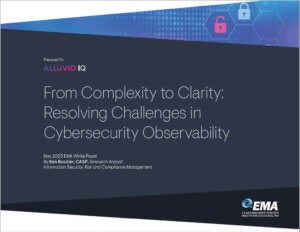
Traditional security tools like Security Information and Event Management (SIEM) and Security Orchestration, Automation, and Response (SOAR) are only as good as the intelligence that they ingest.
In a recent report from Enterprise Management Associates (EMA), Analyst Ken Buckler reflects on why SecOps needs to leverage observability data for faster, more complete incident response.
Cybersecurity facing mounting challenges
According to Buckler, modern cybersecurity faces a range of challenges that IT leaders must overcome to ensure effective threat detection. One example is the complexity of today’s networks, which feature copious devices, endpoints, and applications. This complexity hinders SecOps’ ability to gain consistent monitoring of the environment for threat detection.
The exponential growth of data volume by network devices and applications, analyzing and processing this data in real time is a formidable task. It demands scalable data collection, storage, and analysis techniques, plus advanced technologies, like machine learning, correlation, and automation. As a result, insufficient visibility into certain network constructs, devices and applications lead to security blind spots. Addressing this challenge involves implementing standardized monitoring practices and utilizing network visibility tools to enhance observability.
Integration is essential
Integrating observability with existing security tools is vital for a comprehensive security posture. However, the complexity and diversity of security technologies pose integration challenges. Overcoming this obstacle requires careful planning, ensuring interoperability, and leveraging automation and orchestration capabilities.
To tackle these challenges, organizations must invest in comprehensive observability solutions, such as Riverbed IQ, that encompass real-time monitoring, advanced analytics, and intelligent automation. By implementing standardized monitoring practices, utilizing efficient data processing technologies, enhancing visibility through full-fidelity telemetry, and integrating observability with existing security tools, organizations can bolster threat detection, incident response, and overall cybersecurity resilience.
Riverbed IQ automates cybersecurity incident response
Riverbed IQ can aid in the investigation of cyberthreats using the Riverbed LogiQ Engine intelligent automation capabilities. It investigates threats found in traditional security tools, like SIEM or SOAR solutions. The SIEM or SOAR initiates a request for supporting diagnostic data using an API. Riverbed IQ then parses this request and the kicks off a low-code security runbook that automates the collection of network forensics data from across the Riverbed ™ portfolio or from third-party data. By distilling the forensic data and sending actionable insights back to the requesting solution, SecOps teams gain easy access to the supporting data they need to drive intelligent security investigations and mitigate cyber threats.
For more information on the need for observability data in cybersecurity, read the EMA white paper, From Complexity to Clarity: Resolving Challenges in Cybersecurity Observability.
